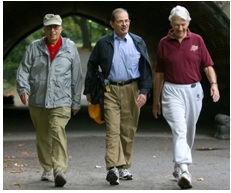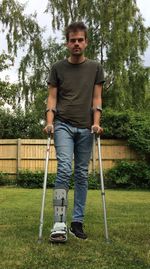Weight bearing: Difference between revisions
Jeremy Bryan (talk | contribs) No edit summary |
Jeremy Bryan (talk | contribs) No edit summary |
||
| Line 9: | Line 9: | ||
Injuries or surgeries most commonly indicating a lower weight bearing status include total or partial joint replacements, bone fractures (surgically and non surgically repaired), and tendon or ligament repairs. | Injuries or surgeries most commonly indicating a lower weight bearing status include total or partial joint replacements, bone fractures (surgically and non surgically repaired), and tendon or ligament repairs. | ||
== Weight Bearing | == Weight Bearing Status == | ||
===Non Weight Bearing (NWB)=== | ===Non Weight Bearing (NWB)=== | ||
NWB status means the patient is not to put any weight through the affected limb(s). | NWB status means the patient is not to put any weight through the affected limb(s). In the case of a lower limb, this includes not resting the foot on the ground during standing or ambulation.<ref name=":2">Duesterhaus M, Duesterhaus S. Patient Care Skills. Seventh Edition. Boston, MA, USA. Pearson, 2014.</ref> | ||
===Toe Touch Weight Bearing (TTWB)=== | ===Toe Touch Weight Bearing (TTWB) or Touch Down Weight Bearing (TDWB)=== | ||
The definition of TTWB is poorly defined in the research literature.<ref name=":0">Rubin G, Monder O, Zohar R, Oster A, Konra O, Rozen N. Toe-Touch Weight Bearing: Myth or Reality?. ORTHOPEDICS. 2010; 33</ref> In clinical practice, it is commonly described as having the ability to touch the foot or toes to the floor without supporting weight from the affected limb. The pressure should be light enough to avoid crushing a potato crisp underfoot. | The definition of TTWB/TDWB is poorly defined in the research literature and is only applied to lower limbs.<ref name=":0">Rubin G, Monder O, Zohar R, Oster A, Konra O, Rozen N. Toe-Touch Weight Bearing: Myth or Reality?. ORTHOPEDICS. 2010; 33</ref> In clinical practice, it is commonly described as having the ability to touch the foot or toes to the floor without supporting weight from the affected limb, for the purpose of balance.<ref name=":2" /> The pressure should be light enough to avoid crushing a potato crisp underfoot. | ||
=== Partial Weight Bearing (PWB) === | === Partial Weight Bearing (PWB) === | ||
[[File:2448px-Teenage boy on crutches with walking boot.jpg|right|frameless|269x269px]] | [[File:2448px-Teenage boy on crutches with walking boot.jpg|right|frameless|269x269px]] | ||
PWB is a broad term and can range from anything greater than non-weight bearing to anything less than full weight bearing.<ref>Ebert JR, Ackland TR, Lloyd DG, Wood DJ. Accuracy of partial weight bearing after autologous chondrocyte implantation. Arch Phys Med Rehabil. 2008; 89(8):1528-1534</ref> | PWB is a broad term and can range from anything greater than non-weight bearing to anything less than full weight bearing.<ref>Ebert JR, Ackland TR, Lloyd DG, Wood DJ. Accuracy of partial weight bearing after autologous chondrocyte implantation. Arch Phys Med Rehabil. 2008; 89(8):1528-1534</ref> This status should be accompanied by a percentage figure to further describe the extent of weight bearing. Most sources define partial weight bearing as being 30% to 50% of a patient’s body weight.<ref name=":0" /> | ||
=== Weight Bearing as Tolerated (WBAT) === | |||
WBAT designates that the patient is medically cleared to bear any amount of weight (up to full body weight) through the involved limb. The patient is free to choose how much weight they ultimately bear through the involved limb, withing the confines of comfort, pain, ability, etc.<ref name=":2" /> | |||
=== Full Weight Bearing (FWB) === | === Full Weight Bearing (FWB) === | ||
FWB means no restriction to weight bearing. | FWB means no restriction to weight bearing.<ref name=":2" /> | ||
== Safe Mobility == | == Safe Mobility == | ||
Revision as of 17:40, 13 March 2023
Introduction[edit | edit source]
In orthopedics, weight bearing refers to how much weight or force is put through a specific limb. It is common for a surgeon or treating physician to prescribing a reduced amount of weight bearing for a specific surgery or injury. Adherence to this reduced weight bearing status is vital for optimal recovery, as prematurely increased weight bearing can delay healing.[1][2] A reduced weight bearing status can be applied to either an upper or lower limb.
It is important to note that walking is inherently an activity requiring single leg stance and as such, a person with no physical limitations will carry all of their body weight through each leg at different points in the gait cycle.[3] Therefore, having a reduced weight bearing status, for a lower limb, can have wide reaching impacts on walking and ambulation.
Injuries or surgeries most commonly indicating a lower weight bearing status include total or partial joint replacements, bone fractures (surgically and non surgically repaired), and tendon or ligament repairs.
Weight Bearing Status[edit | edit source]
Non Weight Bearing (NWB)[edit | edit source]
NWB status means the patient is not to put any weight through the affected limb(s). In the case of a lower limb, this includes not resting the foot on the ground during standing or ambulation.[4]
Toe Touch Weight Bearing (TTWB) or Touch Down Weight Bearing (TDWB)[edit | edit source]
The definition of TTWB/TDWB is poorly defined in the research literature and is only applied to lower limbs.[5] In clinical practice, it is commonly described as having the ability to touch the foot or toes to the floor without supporting weight from the affected limb, for the purpose of balance.[4] The pressure should be light enough to avoid crushing a potato crisp underfoot.
Partial Weight Bearing (PWB)[edit | edit source]
PWB is a broad term and can range from anything greater than non-weight bearing to anything less than full weight bearing.[6] This status should be accompanied by a percentage figure to further describe the extent of weight bearing. Most sources define partial weight bearing as being 30% to 50% of a patient’s body weight.[5]
Weight Bearing as Tolerated (WBAT)[edit | edit source]
WBAT designates that the patient is medically cleared to bear any amount of weight (up to full body weight) through the involved limb. The patient is free to choose how much weight they ultimately bear through the involved limb, withing the confines of comfort, pain, ability, etc.[4]
Full Weight Bearing (FWB)[edit | edit source]
FWB means no restriction to weight bearing.[4]
Safe Mobility[edit | edit source]
For the lower extremity, NWB, TTWB, and PWB require the use of a wheelchair or assistive device to maintain compliance during mobility. In the case of FWB or WBAT, an assistive device may be needed if other impairments (ex. pain, impaired balance, muscle weakness, abnormal tone) act as barriers to safe ambulation or contribute to significant gait deviations.
The video clip below illustrates each type of weight bearing status and the assistive devices that may be needed to facilitate compliance.
Measures of Adherence[edit | edit source]
There are a variety of ways to measure adherence to weight bearing restrictions. Clinically, adherence is commonly measured by observation, scales, placing a hand under the foot of an affected limb, and biofeedback.[8]
Little research on been done on the accuracy and reliability of observation and manual assessment.[8] Particularly at lighter weights, the accuracy of scales can be difficult to replicate. They appear to most useful for assessing symmetry in static standing for patients who are WBAT. Although biofeedback is the most accurate measure of adherence, cost may pose a barrier to clinical use.[8]
Physical Therapy Applications[edit | edit source]
Physical therapists need to be aware of patients who have weight bearing restrictions. If restrictions are unclear, they should be clarified with the treating physician. In turn, this will influence the content of patient education, caregiver training, goals of treatment, and the types of devices that may be used for mobility.
References[edit | edit source]
- ↑ Augat P, Merk J, Ignatius A, Margevicius K, Bauer G, Rosenbaum D, Claes L. Early, full weightbearing with flexible fixation delays fracture healing. Clinical Orthopaedics and Related Research®. 1996 Jul 1; 328:194-202.
- ↑ Mavčič B, Antolič V. Optimal mechanical environment of the healing bone fracture/osteotomy. International orthopaedics. 2012 Apr 1;36(4):689-95.
- ↑ Fruth S. Fundamentals of the Physical Therapy Examination. Second Edition. Burlington, MA, USA. Jones and Bartlett Learning, 2018.
- ↑ 4.0 4.1 4.2 4.3 Duesterhaus M, Duesterhaus S. Patient Care Skills. Seventh Edition. Boston, MA, USA. Pearson, 2014.
- ↑ 5.0 5.1 Rubin G, Monder O, Zohar R, Oster A, Konra O, Rozen N. Toe-Touch Weight Bearing: Myth or Reality?. ORTHOPEDICS. 2010; 33
- ↑ Ebert JR, Ackland TR, Lloyd DG, Wood DJ. Accuracy of partial weight bearing after autologous chondrocyte implantation. Arch Phys Med Rehabil. 2008; 89(8):1528-1534
- ↑ Clin skills 2 patient skills. Assistive devices and weight bearing status. Available from: https://www.youtube.com/watch?v=_0Ddj1eUcXU&feature=youtu.be (last accessed 4.4.2019)
- ↑ 8.0 8.1 8.2 Hurkmans H. Partial Weight Bearing: Long-term monitoring of load in patients with a total hip arthroplasty during postoperative recovery. 2005 Nov 16.








